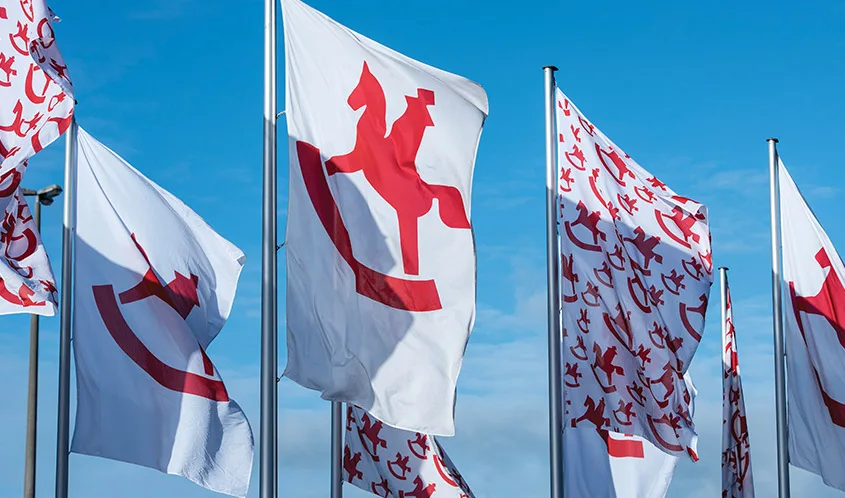by CHRISTOPHER BYRNE, The Toy Guy, president, Byrne Communications
Another trade show? Really? The dizzying round of shows stretching from Hong Kong and Dallas in October to New York in February can sometimes feel daunting to people in the toy industry. Yet the benefits go well beyond the accumulation of frequent flyer miles. Even in a business environment where so much is done online, trade shows are hardly a relic of the past. Rather, they are an essential tool for education on the latest industry development, expansion of distribution, and experiencing the range of product offerings, as well as seeing the emerging trends that will potentially drive the business in the year ahead. All of this is to say nothing of the networking opportunities and person-to-person contacts that are still essential to the business.
The 71st Spielwarenmesse in Nuremberg, Germany, running from Jan. 29-Feb. 2, remains the largest toy trade show in the world, showcasing more than 1 million products. Taking up 12 full halls (14 if you add in 3A and 4A), one almost needs endurance training to see it all. Still, it is worth it. (And who doesn’t want a chance to work off all those great Nuremberg sausages and other German food?)
A Gateway to the Global Toy Market
For exhibitors, the show provides an important gateway to all of Europe and the rest of the world. Andrew Kamondy, CEO of the startup Twist Toys, says that a presence at the Nuremberg show is crucial. He acknowledges that it is important to go into the show with major distribution deals already signed because by the time the show hits, sometimes it is too late to have a line taken by some of the major retailers in Europe. However, he says, “As a new company, the show is the best way to meet new, potential distributors in companies that you don’t have access to.”
Kamondy hopes to secure distribution deals in both Slovenia and Croatia at the show, in addition to exploring other expanded or completely new deals. As a startup, Kamondy says this is an important place to connect with the people who can help drive his business. Spielwarenmesse estimates that there are more than 32,000 visitors and more than 830 exhibitors for whom this is the only toy trade show they attend.
A Platform for a World-Class Showing
Playmobil is a German company that has permanent space at the Spielwarenmesse. Marc Shinderman, vice president of sales and marketing for Playmobil USA, says that the space (Hall 12, Stand P07) allows Playmobil its most expansive product display. The show is also a global platform for the company, which has two distinct lines: one for Europe and one for the U.S. He notes that the show allows the company to work with representatives from any territory around the world.
There’s also a certain level of drama at trade shows, at least when it comes to unveiling product. “Nuremberg is where all our embargoed product is finally revealed,” Shinderman says. “It won’t be in our catalog until after the show, and then it becomes public.” This has been a particularly effective strategy for the company in recent years as it moves into more licensing and entertainment-based product. Like many toy companies, he adds, Playmobil is “morphing and changing into an entertainment company.” It’s a great venue to show all of that to the world.
Spotting the Trends that May Impact the Business
The Spielwarenmesse is also where the industry gets a look at the year’s emerging trends, how they’re being interpreted in toys, and what companies are banking on sticking. Seriously, were we even thinking about llamas 18 months ago?
Global trend hunter and toy expert Reyne Rice has some tips for visitors to the show who are hoping to get a glimpse of what’s ahead. She suggests starting in Hall 3A, where the trends and innovations are the main focus. Guests can visit the TrendGallery to see demonstrations of the global toy trends and displays featuring the ToyAward nominees and winners. The New Exhibitors Area (NEC) showcases new startup manufacturers.
“Trade guests can attend free, short, top-of-trend sessions in the Toy Business Forum, presented by world-class industry experts about future trends, licenses, retailing tips, and social media know-how,” Rice says. “Plus, snag your free Trends and Innovations Guide as a handy desk reference for the rest of the year.”
In addition to the work of Rice and other trend experts, the Spielwarenmesse also publishes its own list of trends to watch. Trend-predicting is more of an art than a science, but focusing on cultural shifts, developments in technology, and — most importantly — the issues that are animating discussions often is a combination of watching cultural movements and gauging issues and attitudes. In many cases, these trends will filter down into the kids’ business.
For this year, the Spielwarenmesse has identified three trends that will shape the business: Sustainability in Play, Digital Gets Physical, and Be You!.
The Sustainability in Play trend has implications far beyond just the physical toys themselves. Particularly for millennial and Gen Z parents, sustainability is a key element in purchase decisions. The challenge in the toy industry is that as a largely plastic-based business, it heavily relies on petroleum. Nonetheless, look for innovations, such as Hasbro phasing out plastic in packaging and other environmentally friendly production innovations.
Companies specializing in building and construction toys, such as LEGO, are also looking at ways to recycle bricks. The company is currently running a pilot program with the charity Give Back Box to determine the feasibility of collecting, cleaning, and refreshing LEGO bricks, which are then donated to school programs and Boys and Girls Clubs.
At the same time, as kids become increasingly aware of the encroaching climate crisis, there will be an increased emphasis on toys that promote environmental awareness.
The Digital Gets Physical trend refers to characters from digital worlds expanding into toy products. This is a trend that we’ve seen evolving over several seasons, and the Spielwarenmesse highlighting this indicates that the trend will simply continue. What’s significant about this licensing compared to traditional entertainment licensing is that these properties tend to appeal to niche audiences. The niches may be comparatively narrow, but they are deep. Concurrent with this is the continuing rise of fandom as a trend, bringing older consumers into the toy market and providing opportunities for marketers to expand their offerings.
The final trend identified by the Spielwarenmesse is also very timely. Be You! focuses on the toy industry’s ability to serve a broader and more diverse consumer than ever before. According to the show organizers, “Play connects everyone irrespective of origin, religion, or appearance. This is the fundamental principle of this trend, which brings together two objectives: to help people with special needs and to promote tolerance, inclusion, and diversity. People with disabilities or diseases, such as dementia or Parkinson’s, have very different tactile requirements when it comes to toys and games. Products within this theme stimulate their minds and motor skills while creating shared experiences.”
While some of these toys are literal, such as Mattel’s Creatable World, which allows kids to imagine everything from the doll’s gender to its outfit, companies have bigger opportunities to leverage diversity into less literal areas that focus on individual kids and their individuality or special needs. The movement has already started with two programs in the UK. The #toylikeme and the Let Toys Be Toys movements seek to destigmatize disabilities and gender bias, emphasize play as an individual experience, foster wide varieties of play, and allow kids to develop naturally in their own way.
Of course, this is a larger issue than individual toys, but it represents a growing cultural sensibility and one that companies can’t ignore, particularly when targeting parents and caregivers for whom these issues are top of mind and have a significant impact on their purchasing decisions.
So, yes, in light of all of this, you probably do need to be on the way to Nuremberg in January. From business opportunities and reaching a broad audience to seeing how the industry is shaping up for the year, it’s an ideal location to get that all-important global perspective.
This article originally appeared in the December/January 2020 issue of the Toy Book.


